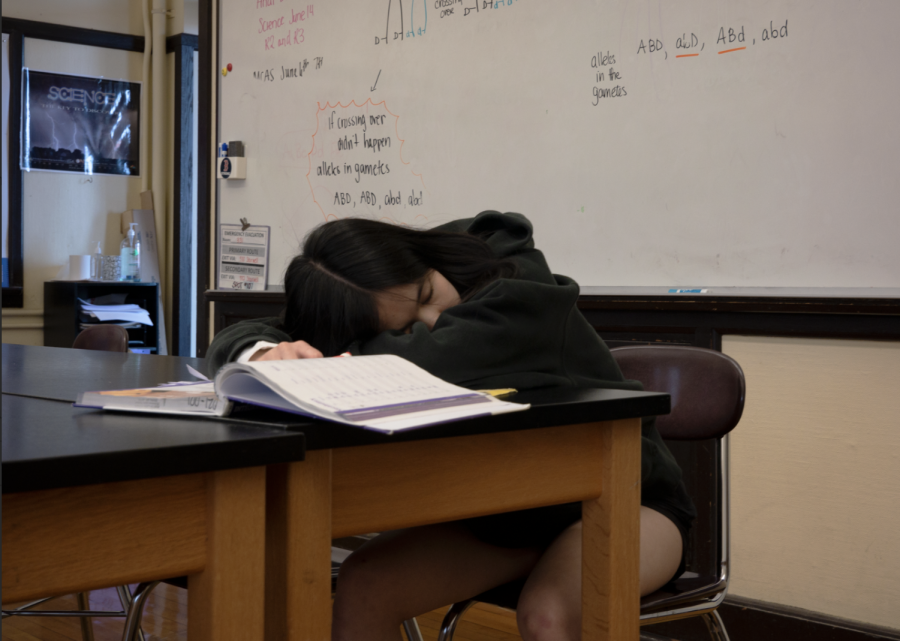Snoozing: The Key to Cruising Through High School
In the fast-paced world of Boston Latin School, where academic demands, extracurricular activities and social commitments collide, students often find themselves needing a nap. It is common to see students nodding off in class, struggling to keep their eyes open and fighting a losing battle against sleep. Amid the hustle and bustle of students’ academic lives, a question arises: the last time students experienced the bliss of nap time was back in preschool, but does it have to remain a distant memory?
Nap time might be viewed as an unconventional solution for high schoolers’ sleep deprivation. The teenage years, however, are a critical period of growth and development, and sleep plays a crucial role in supporting growing bodies. As research continues to highlight the importance of sleep for cognitive function and overall well-being, naps for teenagers during school may not be as far-fetched as initially thought.
Not only would nap time enhance focus and productivity during the school day, it could also potentially lead to long-term benefits such as improved academic performance and reduced stress levels. Incorporating sleep into the existing school schedule would be the easiest way to address the lack of sleep and energy that many high schoolers face daily.
Hoa Nguyen (IV) shares his firsthand experiences with sleep deprivation relating to classroom engagement: “I constantly struggle to stay awake during class, and it makes it that much more difficult to even understand what is going on. I often sacrifice some of my other important times during the school day to catch up on sleep, like during my studies or even lunch.”
Implementing nap time would resolve many of these problems and provide a dedicated period for students to recharge their minds and bodies. Rather than struggling with fatigue and dropping concentration levels throughout the day, students would have the opportunity to replenish their energy levels and enhance their ability to engage actively in their studies or extracurricular activities with an organized nap time.
Getting enough sleep could also have long-lasting benefits as students transition into college and adulthood. Naps can go beyond physical rest; they create time for mental rejuvenation and stress reduction. This extra help allows students to navigate the challenges of adolescence more effectively.
For younger students especially, significant transitions, more academic pressure and more social or emotional complications are hallmarks of their teenage years. Integrating a brief period of rest into the school day could provide a much-needed break, promote good mental health and reduce risk of burnout from anxiety-related issues.
“High school life can be tough with so much pressure put on you, such as maintaining good grades and maintaining healthy relationships, which can further cause stress and anxiety,” says Benjamin Leung (IV). “However, it could be helped by having nap time in schools, which will allow people to catch up on sleep and help a person instead of punishing them.”
Adding an entire period dedicated to sleeping into the school day does, however, raise questions about its feasibility; especially after looking at the standard BLS schedule, it seems challenging to allocate time for napping. The idea of designated sleeping periods, however, is realistic.
When asked about this topic, BLS Spanish teacher Mrs. Denise Rodrigues Akkus offered a solution: “One idea would be during studies. […] It’s a time that you could nap. Granted, you’re sitting in those chairs and at those desks, because I don’t see what other space [there is]. I do think some students have already implemented their own time during Study Hall.”
By utilizing available spaces such as empty classrooms, high schools can create designated nap zones allocating additional costs for renovations or changes. This approach would allow schools to address the importance of rest and sleep for students while keeping their budget in check.
As we navigate our BLS lives, let us remember the importance of rest and rejuvenation; nap time can become a cherished tradition once again. After all, a little shut-eye might just be the secret to unlocking our full potential and making a healthy high school life a dream come true.







